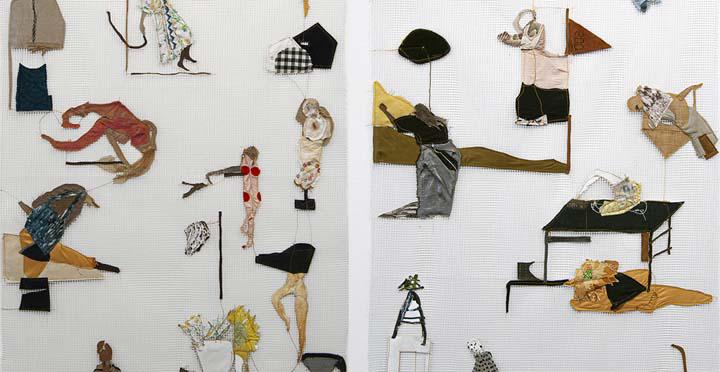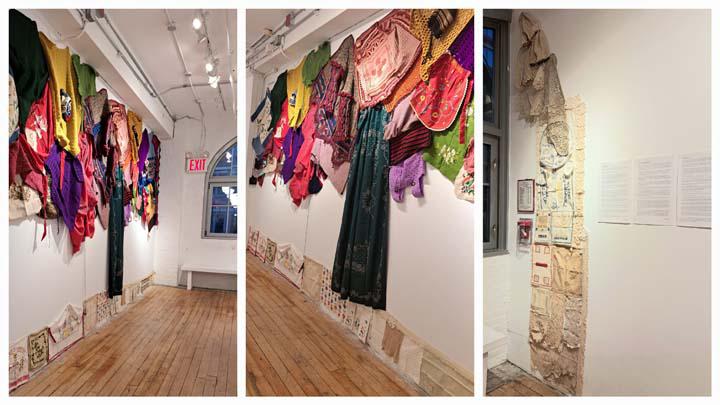The DART Board: 05.15.2024
Maurizio Cattelan | Sunday at Gagosian
In this new installation, Cattelan doubles down on his response to economic inequality in America, using precious metal to deconstruct the country’s relationship to the accessibility of weapons (a condition against which privilege affords no defense). Panels of stainless steel, plated in 24-karat gold, have been “modified” by gunfire. The components’ formerly smooth surfaces are left riddled with craters and holes, evoking a history of guns in art that stretches from Edouard Manet’s The Execution of Emperor Maximilian (1868–69) to Chris Burden’s Shoot (1971) and William Burroughs’s shotgun paintings.
Visitors to Gagosian’s 21st Street location are immediately confronted by a towering, 17-foot-tall wall of the gilded panels that stretches some 68 feet wide. In front of it is November (2024), a marble fountain that portrays a slouching figure urinating on the ground. Cattelan characterizes the work as “a monument to marginality,” an image of a reality that we habitually ignore.
Cattelan traces the opulent composition of these new works back to the Catholic spiritual tradition in which he was raised, also pointing out that the ease of melting down and reusing gold gives the material a fungible, unfixed nature that allows it to effectively disappear. Even when dealing with such sensitive subjects, however, he remains a “Sunday” artist at heart, avoiding explicit judgment in favor of presenting reality as he observes it.
Gagosian, 522 West 21st Street, New York, NY Info
Extended through May 19: The Golden Thread extended at the Seaport
BravinLee Programs, organizers of The Golden Thread: A Fiber Art Exhibition, has just announced that this popular show has been extended. The exhibition presents 61 artists and over 100 of their artworks, including 10 site-specific installations. Above: Fanny Allié, Sunflower & 200 (detail)
A practice that encompasses embroidery, tapestry, quilting, carpet design, and much, much more, textile art has undergone a renaissance over the past century. Artists of all types and from every corner of the planet have pushed hard on what can be termed textile, and even harder on the ways in which textile can be considered art. Once marginalized from the hidebound concept of “fine art” because of its functional origins, textile art now appears poised to take advantage of its previous outsider status—principally by asking questions of art’s presumed hierarchies.
The exhibition takes up every floor of the 18th-century building it’s situated in, from dedicated displays of Ray Materson’s bite-sized embroidery compositions to enormous, site-specific installations like that of Melissa Webb (above).
The Seaport Museum, 207 Front Street, New York, NY Info
Continuing through May 19: Common Threads at Carter Burden
When I am dead and in my grave / And all my bones are rotten / When this you see, remember me / That I am not forgotten.
Drawing inspiration from this poignant 18th and 19th-century poem, which was embellished onto a vintage embroidered textile, artist Ann Kronenberg delves into the notion that the artistry of needlework often outlasts the needleworkers themselves. In When This You See, Remember Me (above), Kronenberg reimagines discarded textiles as components of a monumental fabric assemblage, exploring craftsmanship, memory, and preservation in homage to the enduring legacy of needleworkers.
Over the span of five decades, Kronenberg collected a diverse array of handcrafted items and fragments. These treasures, sourced from used textile dealers, thrift shops, and personal connections, and wove together a narrative of craftsmanship and tradition. Each piece carries with it a story—a testament to the dedication and skill of its creator. Kronenberg states, “The installation is completed by written accounts of the histories of selected needlework components—an effort to remember and honor my needlework collaborators, both the known and the anonymous.”
Carter Burden Gallery, 548 West 28th Street, #534, New York, NY Info

Sunday, May 19, 3-5pm: Olivia Beens | Fading Out at Salon 37
Kodak’s commercial slogan during the 1950s was: “For sparkling pictures big as life. . . . Kodak 35 mm color slides.” A 35 mm slide, a high-resolution positive photograph, can be magnified by a factor of 100 (to 3,500 mm) and still maintain a crisp and detailed projected image. In Fading Out, 35mm slides, once ubiquitous in an analog world, are used by artist Olivia Beens as fodder for art. This installation was created from an assemblage of thousands of slides she once used to document her work, capture family and friends, record travel adventures, and serve as reference material for performance art. These cardboard and acetate squares are strung together to create curtains of light and color. The viewer is invited to intimately scrutinize these tiny images using magnifiers are provided for viewing.
The space becomes a theatrical set inviting the viewer to create their own narrative or simply visit a bygone era. A large figure commands the floor and seems to dance disco style swaying her long arms studded with copper and glass eyes. In a digital world 35mm transparencies have been rendered obsolete, unnecessarily. The artist ceremonially summons aspects of life in the mid-1980’s and 1990’s.
Salon 37, 37 Canal St @ Ludlow [3rd floor walkup], New York, NY Info

Van Doren Waxter presents Richard Diebenkorn: Faces and Figures at the gallery’s 1907 townhouse on the UES. Organized with the Richard Diebenkorn Foundation, the exhibition includes a sweep of taut, psychologically complex portraits made during the distinguished American painter, draftsman, and printmaker’s mature representational period, The exhibition includes seven paintings and fourteen works on paper made by the artist between 1955 and 1967.
A must-see for aficionados of Richard Diebenkorn, the show marks the first time his rarely seen Two Nudes (left), 1960—a beguiling, seven foot tall oil that anticipates the scale of the monumental Ocean Park abstractions he would begin in 1967—has been on view in 60 years. “A meandering blue background,” enthuses art historian Stephanie Lebas Huber in the show’s accompanying essay, “sculpts the figural pair by cutting into the flesh-tones with layers of blue, in some cases even defining their bodies with a contour line of the same hue.” Huber writes that Henri Matisse’s “long-standing influence over Diebenkorn’s color palette and subject matter is evident,” noting that Diebenkorn had closely studied works he had seen in a 1952 Matisse retrospective at the San Francisco Museum of Art.
Van Doren Waxter, 23 East 73rd Street, New York, NY Info






